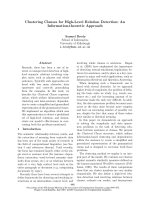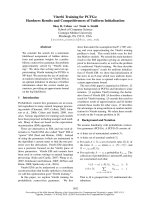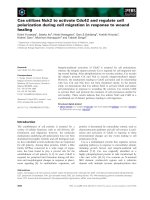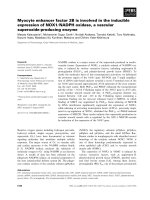Báo cáo khoa học: " Risk Factors for High Endoparasitic Burden and the Efficiency of a Single Anthelmintic Treatment of Danish Horses" doc
Bạn đang xem bản rút gọn của tài liệu. Xem và tải ngay bản đầy đủ của tài liệu tại đây (72.36 KB, 8 trang )
Larsen MM, Lendal S, Chriél M, Olsen SN, Bjørn H: Risk factors for high en-
doparasitic burden and the efficiency of a single anthelmintic treatment of Danish
horses. Acta vet. scand. 2002, 43, 99-106. – A questionnaire survey regarding en-
doparasite control practices in Danish horse herds was carried out in 1995. The partici-
pating veterinarians and herd owners were sampled using convenience and purposive
sampling. In the analysis of risk factors for development of a high endoparasitic burden
(>200 eggs per gram faeces) 903 horses were sampled and the analysis of the efficiency
of a single anthelmintic treatment was based on 605 horses. The following factors had
a significant effect on the endoparasitic burden: herd type, age of the horses, use of pas-
ture rotation, anthelmintic treatment of horses visiting the herd, use of an adviser in the
planning of endoparasite control and advice regarding pasture rotation. An interaction
between pasture rotation and advice regarding pasture rotation was found, but due to
high collinearity this was not reported. The factors influencing significantly on the re-
duction of the faecal egg count after a single anthelmintic treatment were the type of
herd, the age of the horse, the drug used, and the anthelmintic-resistance-status of the
herd. A negative effect of permanent pastures was observed. If pasture hygiene was per-
formed on the advice of the veterinarian, the effect of a single anthelmintic treatment
was less compared to a single anthelmintic treatment without any advice. An interaction
between the treatment group and the resistance-status of the herd was found. Additional
factors, normally accounted for, when endoparasites and anthelmintic resistance is dis-
cussed, were investigated, but not found significant in this study.
endoparasites; epidemiology; anthelmintic resistance.
Acta vet. scand. 2002, 43, 99-106.
Acta vet. scand. vol. 43 no. 2, 2002
Risk Factors for High Endoparasitic Burden and
the Efficiency of a Single Anthelmintic Treatment of
Danish Horses
By M.M. Larsen
1
, S. Lendal
1
, M. Chriél
1
, S.N. Olsen
2
and H. Bjørn
3†
1
Department of Animal Science and Animal Health, Epidemiology, and
2
Department of Clinical Studies, Large
Animal Medicine, The Royal Veterinary and Agricultural University, Frederiksberg, and
3
Department of Veteri-
nary Microbiology, Danish Veterinary Institute, Copenhagen, Denmark.
Introduction
In Danish horses resistance to benzimidazole
products in the Cyathostominea spp. has been
reported twice (Bjørn et al. 1991, Craven et al.
1998) and resistance to pyrantel is suspected
(Craven et al. 1998). Anthelmintic resistance
(AR) is regarded as an increasing problem
worldwide, but the factors that contribute to the
development of AR are often speculative. Epi-
demiological techniques have enhanced the
ability to study the complex interactions be-
tween factors that may contribute to the occur-
rence of AR. High frequency of treatment
(Wescott 1986), repeated use of anthelmintics
with the same mode of actions (Herd 1992), the
generation intervals of the parasites (Dangolla
1994) are factors which have been associated
with the risk of development of AR in produc-
tion animals. A low efficiency of a drug might
†
Deceased December 2001
be an indication that AR has developed. Some
parasites survive treatment, what facilitates se-
lection of AR parasites (Prichard 1994). This
makes it necessary to investigate the associa-
tion between AR and management strategies,
which potentially could contribute to its devel-
opment. Factors previously identified in other
production animals are also expected to be im-
portant for the development of AR in the
horses, but as horses often are handled as a
companion animal other factors might con-
tribute to the development of AR.
The objective of this study was 1) to identify
risk factors associated with high endoparasite
burden and 2) to evaluate the efficiency of a
single anthelmintic treatment of Danish horses.
Materials and methods
In 1994 veterinarians from "The Danish Horse
Practising Veterinarian Society" were con-
tacted, and 22 veterinarians entered the survey
and selected large (>15 horses) horse herds
among their clients. In 1995 a questionnaire
was sent to the selected herd owners. Sixty-
eight herd owners answered the questionnaire,
and 56 of the selected herds with a total of 903
horses entered a Faecal Egg Count Reduction
(FECR) test (Craven et al. 1998).
In 1997 the herd owners were interviewed with
the aim of validating the questionnaire (Lendal
et al. 1998).
Data analysis
Initially bivariate analyses were performed, and
variables having p-values below 0.15 were in-
cluded in the multivariate analysis (Table 1). A
2-level model was analysed in order to evaluate
potential clustering of horses within herds. Due
to absence of significant clustering, the data
were consequently analysed as a single layer
model. Variables were included in the model if
p≤0.05.
Risk factors for high endoparasite burden
The bivariate and the multivariate logistic re-
gression analyses were based on the 903 horses
with faecal egg counts measured as "Eggs Per
Gram faeces" (EPG). The conceptual model
was as follows:
Y
i
= ß
0
+ Xß + e
0i
e
0i
~ N(0,Ωe
0i
), Ωe
0i
= σ
2
e
0i
and denotes the
residual variation.
Y
ijk
is binominal distributed (π
i
,1).
The estimation procedure fixed the dispersion
parameter to 1. The dichotomized response
variable was defined as EPG pre-treatment
count, where one group required anthelmintic
treatment (463 horses with EPG ≥200) and the
other group did not require treatment (592
horses with EPG <200). The cut off for treat-
ment was chosen because this level allows suf-
ficient infection to induce immunity, but devel-
opment of massive infection is prevented
(Uhlinger, 1991). EPG used in this study con-
sisted only of Cyathostominea spp. The ordi-
nary logistic regression model parameter vector
ß was estimated by maximum likelihood esti-
mation. The confidence interval of the esti-
mates was based on Wald’s statistics.
Efficiency of a single anthelmintic treatment
The bivariate and the multivariate regression
analyses were based on 605 horses. The con-
ceptual model was:
Y
i
= ß
0
+ Xß + e
0i
e
0i
~ N(0,Ωe
0i
), Ωe
0i
= σ
2
e
0i
and denotes the
residual variation.
Y
i
~ N (Xß,Ω).
The response variable was defined as the differ-
ence between the natural logarithm of the EPG
pre-treatment count and the natural logarithm
of EPG 14 days post-treatment count. The ordi-
nary generalised linear model parameter vector
ß was estimated by maximum likelihood esti-
mation. Only horses that were examined with
100 M. M. Larsen et al.
Acta vet. scand. vol. 43 no. 2, 2002
Risk factors and anthelmintic treatment of horses 101
Acta vet. scand. vol. 43 no. 2, 2002
Table 1. Variables extracted from the data and evaluated in the study.
Description and levels
Herd type: Stud farm
Pension
Riding school
Other type (e.g. racing stables)
Age: Foals
Youngsters
Adults
Treatment group: Control
Benzimidazoles
Pyrantel
Ivermectin
Diagnosed AR towards benzimidazoles in
the herd in one or more horses: Yes
No or not known
Pastures are permanent: Yes
No or not known
Pasture rotation used: Yes
No or not known
Horses are grazing together with other species: Yes
No
Horses grazing with horses from other herds: Yes
No or not known
Dung spread on the pastures: Yes
No or not known.
Weight estimation method used: Eye measure
Weigh band
Other methods
Weight estimation used in the dosing of anthelmintics: Mean weight of horses,
Weight of heaviest horse
Individual weight
Others
Anthelmintic treatment at turn out: Yes
No
Anthelmintic treatment at housing: Yes
No
Anthelmintic treatment at Yes
pasture rotation: No
Anthelmintic treatment of Yes
new horses bought: No
Anthelmintic treatment of visiting horses: Yes
No
Problems with diarrhoea are known: Yes
No or not known
Adviser is used in the planning of the endoparasite control: Yes
No
The veterinarian gives recommendations regarding pasture hygienic conditions: Yes
No
The veterinarian gives recommendations regarding time of treatments: Yes
No
The veterinarians recommendations are influenced by the season: Yes
No
The veterinarian gives recommendations regarding number of treatments: Yes
No
The veterinarian gives recommendations regarding choice of anthelmintic product: Yes
No
the FECR test (820 horses) entered the study. A
total of 215 horses were withdrawn due to zero
egg count pre- and 14 days post-treatment.
Results
Risk factors for high endoparasitic burden
The factors influencing the endoparasitic
burden are presented in Table 2. Strong
collinearity was found between the factors "use
of pasture rotation" and "veterinarian gives
advice regarding pasture hygienic measures"
(p< 0.001).
Efficiency of a single anthelmintic treatment
The multilevel model analysis revealed no sig-
nificant clustering between veterinarians or
herds (data not shown). Factors having a signif-
icant influence on the efficiency of an an-
thelmintic treatment are presented in Table 3
and 4. Collinearity between the variable "the
veterinarian gives advice regarding the choice
of anthelmintics" and the variable "veterinarian
gives advice regarding pasture hygienic mea-
sures" was seen (p<0.007).
Discussion
Risk factors for high endoparasitic burden
The risk for high endoparasitic burden was sig-
nificantly increased for horses stabled in riding
schools compared to horses from "other types".
102 M. M. Larsen et al.
Acta vet. scand. vol. 43 no. 2, 2002
Table 2. Descriptive statistics for significant risk factors for high endoparasitic burden (EPG>200) and odds-
ratios (95% confidence limits) from multivariate analysis (n=903 horses).
Risk factors No. of
Bivariate analysis Multivariate analysis
(levels) observ.
Prev. (%) p-value Odds-ratio p-value
Herd type 0.001 0.0001
Stud farm 539 44 0.57 (0.44-0.75)
Riding school 241 48 1.65 (1.20-2.27)
Pension 188 31 0.47 (0.35-0.66)
Other type 87 61
Age 0.001 0.0001
Foals 92 35 0.99 (0.76-1.28)
Youngsters 211 73 4.37 (3.59-5.31)
Adults 736 38
The veterinarian gives recommendations regarding
pasture hygienic conditions 0.001 0.0003
Yes 473 37 1.80 (1.53-2.12)
No 582 49
Anthelmintic treatment
of visiting horses 0.001 0.0008
No 283 35 1.91 (1.57-2.33)
Yes 772 47
Pasture rotation used 0.025 0.0028
Yes 754 45 1.76 (1.45-2.13)
No 200 37
Adviser is used in the planning
of the endoparasite control 0.019 0.0062
Yes 538 47 1.54 (1.31-1.80)
No 517 40
The risk is decreased for horses in pensions and
stud farms. Regarding the pensions it might be
explained by the fact that the proportion of
young horses was small in the pensions or be-
cause the horses often are private owned and
therefore, the most efficient product is used
even though it is the more expensive. In riding
schools the economic output is important and
therefore a tendency to use cheaper drugs and
perhaps fewer treatments could be seen.
The findings regarding the age of the horse in
this study are consistent with the findings in a
study by Love & Duncan (1992). They indi-
cated that the age of the host had an effect on
the cyathostome infection level; the risk of hav-
ing a high endoparasitic burden was higher in
youngsters compared to adult horses. The fact
that foals have lower endoparasitic burdens
could, according to Herd & Gabel (1990), be
due to the fact that foals have not yet acquired
Risk factors and anthelmintic treatment of horses 103
Acta vet. scand. vol. 43 no. 2, 2002
Table 3. Descriptive statistics for risk factors associated with efficiency of anthelmintic treatment (FECR test).
Estimates of the average Egg Per Gram faeces (EPG) reduction (difference between the logarithm of EPG pre-
treatment and EPG post-treatment) with standard errors (SE) and P-values from bivariate and multivariate anal-
ysis are listed.
Risk factors
N
Bivariate analysis Multivariate analysis
(levels)
Mean p-value Estimate (SE) p-value
Herd type 0.0001 0.0001
Stud farm 329 0.4614 -0.0321 (0.0682)
Riding school 130 0.5911 -0.1780 (0.0836)
Pension 88 0.1781 -0.2844 (0.0810) -
Other types 58 0.5556 0 (0)
Age 0.0001 0.0044
Foals 55 0.3415 -0.1326 (0.0673)
Youngsters 174 0.5223 -0.0918 (0.0432)
Adults 376 0.4438 0 (0)
Pastures are
permanent 0.1699 0.0012
Yes 438 0.4476 -0.1527 (0.0471)
No 167 0.4819 0 (0)
The vet gives recommendations regarding
pasture hygienic conditions 0.0650 0.0001
Yes 240 0.3995 -0.1666 (0.0433)
No 365 0.4950 0 (0)
Treatment group 0.0001
Control 233 0.0070
1
Benzimidazole 221 0.5719
1
Pyrantel 81 0.9470
1
Ivermectin 70 1.0261
1
Anthelmintic resistance towards benzimidazoles
in the herd 0.1542
Yes 482 0.4388
1
No 123 0.5286
1
1
See Table 4.
any immunity, which means that a greater accu-
mulation of encysted cyathostominea in the
caecal and colonic mucosa is allowed. In this
stage they do not yet contribute with massive
faecal egg output.
The stocking density is often mentioned when
risk factors for high endoparasitic burden are
discussed (Herd 1987, Bjørn et al. 1991). In
this study it was not possible to calculate and
evaluate the exact stocking density. However, a
previous study indicated that the average stock-
ing density was lowest in pensions (Lendal et
al. 1998), and therefore the horses would not be
forced to graze close to the roughs (Herd 1987)
and consequently have a lower risk of endopar-
asitic infections than horses stabled in riding
schools.
If the herd owner used an adviser in the plan-
ning of endoparasite control or if the veterinar-
ian gave advice regarding pasture hygienic
measures there was an increased risk of high
endoparasitism. This is probably caused by se-
lection procedure, since 53% of the herds were
included due to suspicion of endoparasitic
problems in the herd.
In other studies when factors influencing the
endoparasitic burden are discussed, factors like
pasture rotation (Bjørn et al. 1991), alternate
grazing (Eysker et al. 1986), permanent pas-
tures (Herd 1987) are included as preventive
measures. These factors were also investigated
in this study. It was seen that the risk for high
endoparasitic burden increased if pasture rota-
tion was used. This could have something to do
with the negative effect of the veterinarians’
recommendations regarding pasture hygienic
measures. An explanation could be that horses
perhaps return to a pasture where they have al-
ready been earlier in the grazing season and
therefore a correct pasture rotation procedure
has not been used.
Strategic treatments (Herd et al. 1985) could
also act as a preventive measure. In this study it
was investigated whether there was an effect of
treatment at turn out, pasture rotation, at hous-
ing, introduction of new horses either bought or
visiting horses. Only treatment of visiting
horses was significant and the risk for high en-
doparasitic burden was increased if visiting
horses were not treated with anthelmintics.
It is important to bear in mind that although low
faecal egg counts are found, cyathostomes can
still be present because it is possible to find zero
egg counts even if the horse is severely infected
(Herd 1992). This means that some horses in
this analysis might be false negatives. Fifty
horses (5%) had zero egg counts pre-treatment
and positive egg count post-treatment and they
indicate the minimum number of false nega-
tives. Clinical signs of diarrhoea can be associ-
ated with cyathostomes (Love 1992), but in this
study no association between diarrhoea and
high endoparasitic burden was found.
Efficiency of a single anthelmintic treatment
Horses stabled in riding schools, stud farms or
other types have a higher reduction in the en-
doparasitic burden after a single anthelmintic
treatment than horses stabled in pensions.
Youngsters have a larger reduction and foals a
smaller compared to adult horses. The fact that
there is reduced efficiency of anthelmintics in
foals could, according to Herd & Gabel (1990),
be due to accumulation of encysted cyathos-
104 M. M. Larsen et al.
Acta vet. scand. vol. 43 no. 2, 2002
Table 4. Estimations and standard errors (SE) of
the interaction (p=0.0037) between anthelmintic re-
sistance (AR) towards benzimidazoles in the herd
and treatment group (n=605 horses).
AR towards benzimidazoles in the herd
Ye s N o
Treatment group
Benzimidazole 0,5257 (0,0484) 0,8552 (0,0764)
Pyrantel 0,9976 (0,0695) 0,8700 (0,1049)
Ivermectin 1,0482 (0,0663) 0,8594 (0,2084)
Control 0 (0) 0,1360 (0,0746)
tomes in the caecal and colonic mucosa and in
this stage they are not affected by an-
thelmintics.
The use of permanent pastures (not ploughed or
renewed between grazing seasons) lowered the
efficiency of a single anthelmintic treatment
compared to pastures renewed between grazing
seasons. This is consistent with Herd (1987)
who mentioned that ploughing expose the lar-
vae on the pastures and will lead to death as a
result of desiccation.
If the veterinarians gave advice regarding pas-
ture hygienic measures, the reduction would be
smaller than if the veterinarian did not give this
kind of advice. This might be caused by selec-
tion bias because 53% of the herds were actu-
ally selected by the veterinarians due to suspi-
cion of endoparasitic problems.
A statistical significant interaction between the
pharmacological group and the AR-status of
the herd was found. As expected benzimidazole
treated horses in herds with a diagnosed AR
have smaller efficiency of the anthelmintic
treatment than ivermectin or pyrantel treated
horses.
The effect of strategic seasonal treatments (turn
out, pasture rotation or housing) was evaluated
but all were non-significant. Likewise no effect
of a single treatment of horses when introduced
(newly bought or visiting) was found. The ef-
fect of pasture rotation, alternate grazing, graz-
ing with horses from other herds or the spread
of horse dung on the pasture was also investi-
gated but not significant. There were no indica-
tions of problems with underdosing even
though eye-measure was used as weight estima-
tion method. This has been mentioned previ-
ously as a risk factor for development of AR
(Besier & Hopkins 1988). Advice obtained
from veterinarians regarding annually number
of treatments, choice of anthelmintic, or time of
treatment, did not have any significant effect on
the reduction.
Conclusion
The herd type and the age of the host are the
most important factors both regarding risk for
high endoparasitic burden was increased en-
doparasitic burden and effect of an anthelmintic
treatment. Unfortunately, advice obtained from
veterinarians regarding pasture hygienic mea-
sures had a negative effect on both the risk for
high endoparasitic burden and the effect of
treatment. This means that more emphasis has
to be put on the recommendations provided
from veterinarians on the subject. The herd
owners need to be more aware about the life cy-
cle and epidemiology of endoparasites in order
to obtain a better understanding of the recom-
mendations given by veterinarians in order to
take advantage of these in a more efficient way.
It should be made perfectly clear that the use of
alternative control measures should be ex-
tended and that the use of anthelmintics should
be under more strict control in order to avoid
AR towards the few still effective products.
Acknowledgements
This study was supported by Merial A/S (formerly
MSD-AgVet), Copenhagen, Denmark. The authors
would like to thank the participating veterinarians
and herd owners for taking time to answer the ques-
tionnaires.
References
Besier RB, Hopkins DL: Anthelmintic dose selection
by farmers. Aust. Vet. J. 1988, 65, 193-194.
Bjørn H, Sommer C, Schougaard H, Henriksen Sv
Aa, Nansen P: Resistance to benzimidazole an-
thelmintics in small strongyles (Cyathostominae)
of horses in Denmark. Acta. Vet. Scand. 1991,
32, 253-260.
Craven J, Bjørn H, Henriksen Sv Aa, Nansen P,
Larsen M, Lendal S: A survey of anthelmintic re-
sistance on Danish horse farms, using 5 different
methods of calculating faecal egg count reduc-
tion. Equine Vet. J. 1988, 30, 289-293.
Dangolla A: Epidemiological analysis of helmitho-
logical data from Danish sow herds with empha-
sis on occurrence of anthelmintic resistance. Ph.
Risk factors and anthelmintic treatment of horses 105
Acta vet. scand. vol. 43 no. 2, 2002
D. Thesis. The Royal Veterinary and Agricultural
University, Copenhagen. 1994.
Eysker N, Jansen J, Mirck MH: Control of strongylo-
sis in horses by alternate grazing of horses and
sheep and some other aspects of the epidemiol-
ogy of strongylidae infections. Vet. Parasitol.
1986, 19, 103-115.
Herd RP: Pasture hygiene. In: Robinson, N.E. (edi.):
Current therapy in equine medicine 2. W.B. Saun-
ders Company. 1987, 334-336.
Herd RP: Choosing the optimal equine anthelmintic.
Veterinary Medicine. 1992, 87, 213-239.
Herd RP, Willardson KL, Gabel AA: Epidemiological
approach to the control of horse strongyles. Eq.
Vet. J. 1985, 17, 202-207.
Herd RP, Gabel AA: Reduced efficacy of an-
thelmintics in young horses compared with adult
horses. Eq. Vet. J. 1990, 22, 164-169.
Lendal S, Larsen MM, Bjørn H, Craven J, Chriél M,
Olsen SN: A questionnaire survey on nematode
control practices on horse farms in Denmark and
the existence of risk factors for the development
of anthelmintic resistance. Vet. Parasitol. 1998,
78, 49-63.
Love S: Parasite associated equine diarrhoea. Comp.
Cont. Educ. Pract. Vet. 1992, 14, 642-649.
Love S, Duncan JL: The development of naturally ac-
quired cyathostome infections in ponies. Vet.
Parasitol. 1992, 44, 127-142.
Prichard R: Anthelmintic resistance. Vet. Parasitol.
1994, 54, 259-268.
Uhlinger CA: Equine small strongyles: Epidemiol-
ogy, pathology and prevention. Comp. cont.
Educ. Pract. Vet. 1991, 13, 863-869.
Wescott RB: Anthelmintics and drug resistance. Vet.
Clin. North. Am. [Equine Pract.] 1986, 2, 367-
380.
Sammendrag
Risikofaktorer for høj endoparasitær belastning og
effekt af en enkelt anthelmintisk behandling af danske
heste.
I 1995 blev der foretaget en undersøgelse af praksis
for endoparasitkontrol i danske hestebesætninger.
Data fra hestebesætningerne blev indsamlet gennem
dyrlæger, der havde givet tilsagn om at deltage i un-
dersøgelsen. Der indgik ialt 906 heste i undersøgelse
af risikofaktorer for høj parasitbyrde (>200 æg pr.
gram fæces), og 605 heste i undersøgelse vedrørende
effekten af behandling med anthelmintika (differen-
cen mellem før og efter behandling). Signifikante ri-
sikofaktorer for høj parasitbyrde var besætningskate-
gori, hestens alder, brug af foldrotation, strategisk
anthelmintikabehandling af nye heste, rådgivning om
mulige kontrolforanstaltninger og foldrotation. Der
var vekselvirkning mellem foldrotation og råd om
samme, men på grund af høj grad af collinearitet, er
dette ikke anført. Faktorer, der havde signifikant sam-
menhæng med effekten af anthelmintikabehandling
vurderet ved reduktion i antallet af æg pr. gram
fæces, var besætningskategori, hestens alder, an-
vendte præparat og besætningens anthelmintika-resi-
stens status. Besætninger med permanente græs-
gange havde større effekt af en enkelt behandling end
andre besætninger. Effekten af en enkelt behandling
var mindre, såfremt besætningsejeren gennemførte
græsmarkshygiejniske tiltag som følge af råd fra den
praktiserende dyrlæge. Der var vekselvirkning mel-
lem det anvendte præparat og besætningens anthel-
mintika-resistens status.
106 M. M. Larsen et al.
Acta vet. scand. vol. 43 no. 2, 2002
(Received December 6, 2001; accepted January 21, 2002).
Reprints may be obtained from: Mariann Chriél, Department of Animal Science and Animal Health, Epidemio-
logy, The Royal Veterinary and Agricultural University, Groennegaardsvej 8, DK-1870, Frederiksberg C., Den-
mark. E-mail:









